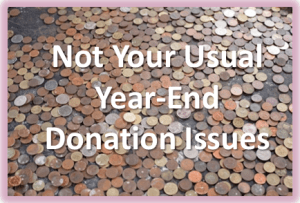 I doubt you’re worrying your pretty little heads about this stuff, but you should be.
I doubt you’re worrying your pretty little heads about this stuff, but you should be.
Because year-end giving is simply too fraught with angst — and it needn’t be that way!
Giving to your nonprofit should be a joyful experience for your donors – before, during and after the transaction.
Not an anxious period of wondering whether their credit card transaction is secure, whether their gift went into a black hole or whether you’ll use it as they intended.
And guess what else?
Receiving donations should be a joyous occasion for you too.
Not an unmitigated nightmare of receiving credit card numbers that don’t work, worrying about how already busy staff can possibly process all your year-end donations and, for that matter, do so in a timely, professional and personal manner.
So give yourself and your donors a break.
How to do this?
How about listening to my friend Bill Sayre?
Recently I had the opportunity to interview Bill, President of Merkle RMG, who spoke with me about some of the issues too few nonprofits adequately consider when it comes to stewarding their donors’ donations so the giving process is joyful. For all concerned parties. Every step of the way.
We spoke about the fact that there’s a lot written about what to do before a gift is made. How to write effective fundraising appeals to help your donors envision being the very best versions of themselves. How to use neuro-psychological research so people’s pleasure centers light up when they’re simply contemplating making a gift.
After that, we fundraisers tend to fall down on the job a bit. After your donor clicks “donate,” what happens next?
How can you make giving pleasurable during and after the experience?
Bill has significant experience with donation processing and fulfillment, and highly recommends planning ahead for these common, and very important, year-end issues:
- Security;
- Timely processing;
- Timely acknowledgment, and
- Cost-effective staffing
Q & A with Bill Sayres, President, Merkle RMG
Online Donation Security
Q. Bill, I know one of your soapbox issues is shining a brighter light on online donation security issues – especially as this relates to donors feeling confident when making a gift through a nonprofit website, whether at a desktop or on a mobile device. What should nonprofits be doing to assure their donors’ personal information is safe?
A. Make sure the right security is in place to protect donations and donor information, particularly at this busy time of year. We’ve seen retail businesses experience notable security incidents given increased traffic at year-end, and nonprofits are not immune to the same challenges. Appropriate preparation to maintain security – and in the process, donor confidence – includes physical security basics, cyber and data security best practices and maintenance of appropriate compliance standards.
You should be thinking about the security of your donor’s data, whether it’s entered by the donor herself or by someone on your staff. If you outsource your data security to a third party, ask them specific questions:
- How they secure their network?
- Is data secured while it’s at rest during the production process?
- How safe are donor credit card numbers?
- What about information scanned in from donors’ checks?
- Is personal information encrypted?
- Who has access donor data? Is it sitting idle on a server with access by multiple people in an un-encrypted format?
- What level of penetration testing does an individual company do? Do they try to hack it on an ongoing basis?
- What level of third party auditing and scrutiny is the vendor under?
I recommend at least an annual security audit by an external firm.
Q. Bill, what should fundraising staff do to assure donations are secure? Sometimes finance or IT staff will assure development departments that everything is “fine,” but is it?
A. It’s a great idea for fundraising staff to take responsibility for assuring their donors’ data is secure. Just because other staff are making assurances, that doesn’t mean you don’t have vulnerabilities. To find out how your current donation processing measures up, take the free assessment on the Merkle website here.
Q. Bill, can small and medium-sized nonprofits handle secure donation processing in-house, or do you recommend outsourcing? I know many of my readers are concerned about costs. What are the pros and cons of outsourcing?
A. Let me give you one example. Nonprofits must comply with Payment Card Industry (PCI) requirements that limit exposure to credit card theft. Anyone who handles payments this way must adhere to these set of requirements – physically and electronically. And they can be complex. Often nonprofits will find they aren’t compliant, and to get compliant will be expensive. Plus it’s an ongoing expense, as organizations must pay an auditor to review standards annually.
Pros to outsourcing this function are (1) to improve response speed and security, and (2) to elevate overall donor care. Let me tell you the results of a survey we recently conducted of 157 nonprofits who outsource their donation processing. They were looking for security in handling funds and safeguarding data, and they were extremely satisfied. Yet those were only the second most frequently referenced satisfaction attributes at 85% and 84% respectively. The top ranked attribute? The ability to quickly acknowledge donor gifts with personalized letters , with 87% of respondents noting it as an important factor in their satisfaction with their outcomes. In terms of cost, only 55% cited price as a key factor.
I think of cost in terms of cost/benefit.
“If you can keep more donors happy, you’re going to keep more donors and get greater value over the long term.”
Donation Processing
Q. Nonprofits are concerned about losing the ability to personalize acknowledgements if they outsource anything other than security. How might outsourcing donor acknowledgements work?
A. Some outsourcers bundle acknowledgements with security. They can handle thank-you’s immediately, rather than waiting to batch gifts and process them periodically. The data is instantly uploaded to you. You can handle personalization yourself, of course. However, they can handle this as well. Or you can do a hybrid version. For example, outsourcers can:
- Have your business rules regarding who, how and when you want to acknowledge folks.
- Autopen the actual signature if you wish.
- Autopen a standard note you like to write on particular thank you letters.
- Hire their own staff to do hand signing.
You can still provide a list of folks you want to handle more personally, and they will send the data directly to you to personalize your own thank you letter. They can also send you an image of donations online, or a separate data file, of donors greater than an amount specified by you.
“Your goal with outsourcing donation processing should be to free up your staff to focus on the next donation.”
Monthly Giving Programs
Q. Bill, let’s shift subjects a bit. I’m often asked about how to start and manage an effective monthly giving program, and I know you have some thoughts on this. Can you talk about (1) why this is a good idea, (2) what some important aspects of a monthly sustainer program might be and (3) how outsourcing donation processing might help small to medium-sized nonprofits to best accomplish this?
A. Sustainer programs should be a no-brainer for nonprofits. What’s so attractive is that you get a very loyal, committed donor. It’s like an annuity for your charity. And your costs to send direct mail to these folks go down.
The challenge is in the management of the program. You’re managing credit card information that expires and changes. You’re dealing with donors who want to suspend their donations for three months over the summer; then reinstate it when they return. How to handle this? This is where the power of outsourcing comes in. And the expense ( literally, just a few dollars per transaction — and not every month; just annually) is really not a barrier when you consider your reduced staff costs and head-aches.
Q. What if a nonprofit is managing their acknowledgements just fine internally now, but to add a sustainer program might mean they’d have to look at hiring an outside vendor?
A. Again, let’s look at cost/benefit. Sustainer donors have a greater lifetime revenue per donor and a higher retention rate than other donors.
“When analyzing giving patterns, sustainer donors are consistently worth between two to four times as much as single gift donors over five years.”
Seamless and secure data processing is a must to make a monthly giving program manageable. You need a system for:
- Fast identification and resolution of exceptions – Validate inputs through pre-process review, discovering and rerouting any issues that require attention for repair or recovery (declined credit cards, expired bank accounts, etc.).
- Flexible payment options, including changes in gift amount and frequency, as well as temporary suspensions.
- Comprehensive donor acknowledgment – Communicate regularly with donors, thank them for signing up as new recurring donors, or confirm changes they have indicated.
- Internal and external reporting – Staff need to be able to measure performance so they know what’s working and what’s not. Additionally, it’s nice to provide donors with detailed information they can use for tax purposes.
Q. Are there any other issues nonprofits should consider before embarking on a sustainer program?
A. To make a sustainer program work you must promote it. No document should go out without the option to sign up for your sustainer program. Every response device should include the option to make a recurring gift. Also, it’s a good idea to educate everyone on your team, including outside vendors, about the benefits of sustainer programs.
“The more staff understand and appreciate the value and benefit of sustainer programs, the more they will serve as ambassadors and champions, increasing participation.”
When you research vendors, ask them how they’ll help you promote your program. For example, good ones will help you to craft your online and offline response devices to assure that everything you need to ask for is included. They’ll also provide you with examples to use as templates.
Making the Case with Leadership
Q. Often development staff are sold on the ideas we’ve been discussing, but how can they persuade their leadership that secure donation processing is important? Even perhaps important enough to outsource to a third party vendor?
A. Ask yourself and your leader: “What is your core competency?” Is it to reach out to prospects and get them on board? Is it to elevate your existing donors to get major gifts or planned gifts?
Donation processing is an offshoot of this. It’s not your core area of expertise. Donation processing companies specifically invest in the technology – to open mail, scan and image donations, etc. So they have economies of scale and spend a lot less per transaction.
You can actually get away with no in-house donation staff this way. Mail opening, deposit, data capture — all can be outsourced. In most cases, vendors can turn the work around more quickly, especially at the end of the year, because they have the appropriate staff. You don’t need to bring in temps and risk having strangers entering data into your database.
Don’t Let Year-End Donors Become One-Time Donors
Thanks so much for these great insights, Bill. I think if I were to sum up your advice, it would be not to let end-of-year donors become one-time only donors. And fundraisers really have it within their power to do this. Because once the gift is made, you’re in control of this process!
So ensure you have the right personnel on hand to deal with an influx in donations and interactions. This may meaning hiring extra temporary help to support timely, accurate deposits of funds and swift donor acknowledgement. Or it may mean outsourcing this function to a third party.
I could not agree more that appropriately engaging and thanking donors can develop the relationships that will lead to lifelong donor/nonprofit relationships.
If you plan ahead this year, you may find you don’t miss that familiar gift-processing head-ache that doesn’t abate until sometime mid-January!
Merkle RMG has been in business since 1983 and began as a processor for nonprofits. Today they are a wholly owned subsidiary of Merkle Inc., the largest privately-held customer relationship marketing agency in the country. Bill Sayre has been Merkle RMG President for 14 years, during which time he has acquired a detailed understanding of the unique needs of fundraisers. Merkle RMG offers inbound telemarketing, donation processing, premium fulfillment and other“ services to organizations with 10,000 to up to 4 million responses/year.
REMINDER TO SUBSCRIBERS:
This is the last week to grab the Early Bird Subscriber Discount for my upcoming Winning Major Gifts Fundraising Strategies e-course.
It’s a whopping 42% discount — just for Clairification subscribers, and just until December 4th. Plus add up to 5 extra staff or volunteers, at no additional cost!






